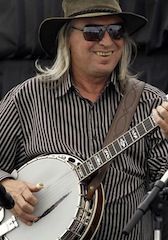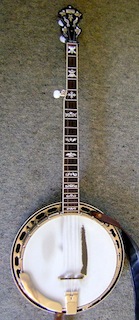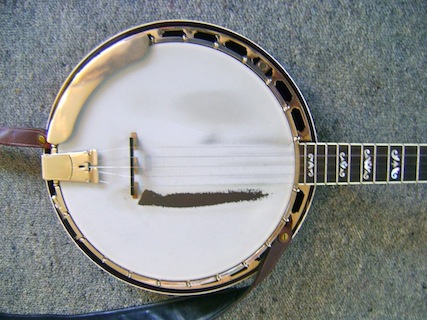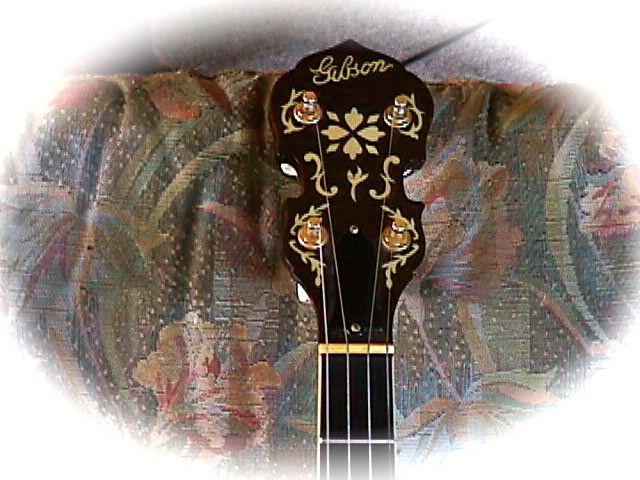|
Instruments Search NZ Folk |
My Instruments
| Fender FB-59 |
| Recording King Elite-75 |
| 1929 Gibson Granada |
Fender FB-59 - Flathead
In early 2007 I acquired a brand new Fender FB-59. I had been looking for some time for an instrument that I would feel OK taking to parties, playing in bars and generally be a banjo which could be easily replaced if it were damaged/lost/stolen. I had been hoping to find a '70s era Ibanez, an instrument which would have filled that slot nicely. Good sound, well made and replaceable.
Well I guess the old Ibanez banjos are more sought after than I had thought, because after 6 months I had still not found one. A chance visit to my friend Alistair Cuthill's music store in Wellington put an end to the quest. He had 2 FB-58s and an FB-59 in stock. I had great fun tuning/picking the 3 of them and spent a really pleasant morning in his store. After a 24 hour cooling off period, I called Alistair to let him know I wanted the FB-59.
When it arrived the first thing I did was to replace the bridge with one of Scott Zimmerman's Z bridges, and next change the strings. During the string changing I decided that I really hated clam-shell tailpieces and fired off an order to First Quality music for a Kerschner. Following the string change, out came the drum-key and I played with various levels of head tension until I got the banjo to sound like a banjo.
Overall I am pleased with the instrument. It sounds like a banjo, is reliable and is nicely finished. After 18 months the gold has mostly worn off the arm-rest, but I can't say I was really surprised by that. In all, it more than meets my need for a reasonably priced instrument.
The thing I like most about the banjo. is the profile of the neck. It seems to me to have just the same feel as the Fender Artist I had 25 years ago (and foolishly parted company with). The fingerboard is slightly wider than a standard Gibson and the neck is thinner through its profile. Having played that old Artist model for so many years, it felt like a home-coming to once more play a Fender, albeit an Asian replica.
I have recorded some sound bites of the banjo, on a Zoom H4 portable recorder, and made them available for download at my sound bites page
I sold the FB-59 in March 2011 and replaced it with a ..........
Recording King Elite-75 - Flathead
| Using the RK-75 Elite at the Auckland Folk Festival 2011 (Photo Jill Jill Guillemin)  |
 |
 |
Since acquiring this banjo in June 2010 from Larry Perkins, it has become my main instrument. It is the most reliable banjo I have ever owned. It stays in tune (well a banjo is never quite in tune but you know what I mean) and is always just ready to be picked.
You can see from the wear on the head just how much use I have had from it. Also, the nickel plate on the arm-rest has taken a bit of a beating, but these things are to be expected with an instrument that is frequently used.
The tone is great - a nice even response all the way to top C and it thumps out the lower tones as well as any banjo I have played. It does not have the subtlty of a pre-war Gibson (see below) but it is also not prone to changing its tone completely from one day to the next.
I have used it in several recording sessions and am very happy with the results. For live performance it is just great.
I would not hesitate to recommend Recording King banjos for anyone (beginner to advanced) who is looking for a good reliable, playable instrument.
1929 Gibson Granada - Archtop
 |
 |
In 1983 I was fortunate enough to acquire a 1929 Gibson Granada archtop tenor banjo. It came to me in its original case fitted with 3 rusty strings, a motley collection of tuners (none of which were original to the banjo), a non-descript cheap japanese tailpiece and a rather worn Rogers vellum. I briefly had one of those "OMG - all that money for this!!!" moments and then set about organising a small amount of refurbishment to restore it to playing condition.
I took the whole kit and caboodle up to Chris Warner in Hanover, Pa and had him make a 5-string neck and do a proper setup on the banjo. After waiting for what seemed forever, (in reality less than a month) I journied back up to Hanover from my home in Arlington, Va and proudly took delivery of an instrument that has been with me ever since. I just could not believe the transformation from the horrible horrible [1] sounds that it made when I tried to play it in its original state, to a banjo with a sound that can only be described as "pre-war".
The banjo has served me in good stead since then. I have come to accept that as it approaches its 80th year, it is getting a little creaky and temperamental. Some days it will just not go into tune. Other days it seems to think that it would be a real good idea to start generating wolf-tones every time I hit the 5th string. I have learned to live with these vagaries but when things get untenable, I send it off down to my good friend and luthier, Keith MacMillan, to have him work his setup magic on it.
I used the Gibson for recording all the songs on Beyond Dark Hollow and I hope I have been able to capture the wonderful dynamic range and nuances of tone that these old instruments can produce.
[1] The Philistines amongst you will of course deny that any change occurred :)
Originality
I still have the original tenor neck and bracket hooks from the banjo. The bracket hooks are not really useable, about half of them being very close to breaking. I replaced them all about 5 years ago with a set I acquired from Janet Davis Music.
The Kerschner tailpiece and planet tuners are parts that Chris Warner fitted to the banjo back in 1983. If the current prices for genuine pre-war parts weren't so ridiculous, I would replace them with the real thing (assuming they could be found) but I am very happy with the look, sound and useability of the parts currently fitted. These parts will of course one day be antiques in their own right.
 |
 |
There are more detailed photos here. The banjo is now fitted with a Sullivan conversion flat-head tone ring.